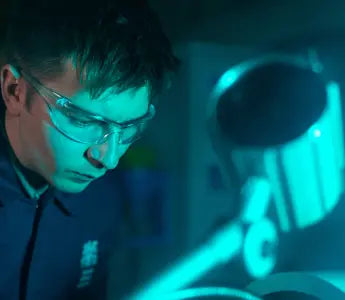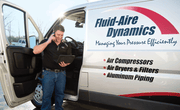The main difference between a single-stage and a two-stage air compressor is the number of times the machine compresses air in its pressure side before sending the air to its tank. Each type of compressor also differs in the shape of its compression cylinder. As a result, two-stage compressors provide air with higher pressure than one-stage compressors.
What Is a Single-Stage Air Compressor?
A single-stage air compressor compresses air in its pressure side only once before delivering it to its tank. It draws air into a cylinder and compresses it at 90-120 pounds per square inch (PSI) before moving it to the attached storage tank. The storage tank holds a large volume of air and maintains the air’s pressure until it feeds air-powered tools.
In a single-stage air compressor, the cylinder holds two pistons of the same size. Due to their equal size, the cylinder has the same physical dimensions on both sides. The pistons draw air through the compressor’s filter element, past its intake valves and into the cylinder.
The pistons push upward as the crankshaft rotates, and the air compresses as the machine forces it through its exhaust valves. It then moves through the compressor’s discharge tube and the check valve until it reaches the storage tank.
What Is a Two-Stage Air Compressor?
A two-stage air compressor is also known as a dual-stage compressor, and it compresses air in its pressure side twice before moving it to its tank. After drawing air in and compressing it, a two-stage compressor then compresses the air again in a second cylinder where it is compressed to a higher pressure at approximately 175 PSI before it cools and moves to the storage tank. This delivers air at a higher PSI so the storage tank can feed more pressure to air-powered tools, which allows them to operate with a high running pressure.
While a single-stage air compressor’s pistons are the same size, a two-stage compressor contains one large, low-pressure piston and one small, high-pressure piston. These pistons both work together to compress the air twice. Because of the different piston sizes, a two-stage compressor’s cylinder also has a different shape with a smaller side and a larger side.
In a two-stage compressor, the larger, low-pressure piston draws air in and through the compressor’s filter before it passes the intake valve and enters the cylinder. The low-pressure piston pushes upward and the crankshaft rotates, compressing the air as the compressor forces it through the low-pressure exhaust valve. The air moves through an intercooler and reaches the pump’s high-pressure side where the cylinder compresses it a second time.
After the second compression, the air moves through the discharge tube and the check valve before it reaches the tank.
Single-Stage vs. Two-Stage Air Compressor
Single-stage and two-stage air compressors are different in various aspects. Since two-stage compressors provide higher-pressure air than single-stage compressors, each machine is suitable for different purposes, and each has different benefits and downsides. Single-stage and two-stage air compressors differ in the following ways:
Applications
Since a two-stage air compressor allows air-powered tools to operate with a higher running pressure, it works best for tools with a high PSI or cubic feet per minute (CFM) rating such as paint guns and blast cabinets. Large-scale operations that require significant air amounts over long periods of time will need two-stage air compressors to meet their needs while smaller facilities can typically operate with single-stage air compressors.
Reliability
Two-stage compressors typically perform better than their single-stage counterparts, and they tend to be quieter while single-stage compressors tend to operate with a higher noise volume. A two-stage air compressor runs cooler and more efficiently than a single-stage one. While a single-stage air compressor can reliably power smaller-scale machinery, a two-stage type is necessary for larger machinery that requires more air pressure for operation.
Cost
Single-stage air compressors typically weigh less and cost less because they contain fewer parts. Additionally, single-stage electric compressors use fewer amps than two-stage air compressors. A single-stage air compressor is an excellent choice for smaller businesses and individual tradesmen because it is more cost-effective for small-scale projects and jobs.
Before you purchase a single-stage or two-stage air compressor, remember that energy-efficient compressors can help you save money on energy costs.
Frequency of Use
Air compressors also differ in the length of time they can power machinery effectively. Single-stage air compressors are best for intermittent use while two-stage compressors are ideal for ongoing operation. Two-stage compressors can handle non-stop use, so they are best for large-scale industrial applications that require ongoing power.
Maintenance
Two-stage air compressors cost more because they contain more parts. However, two-stage compressor parts are smaller and require less frequent maintenance. Even though a two-stage type may cost more, it can save you money on maintenance costs over time.
Temperature
Air temperature also differs between single-stage and two-stage air compressors. Since two-stage compressors send air through an intercooler, the air has a chance to cool before it enters the storage chamber. In a single-stage compressor, the air can overheat quickly if it is overused.
Is a Single-Stage or Two-Stage Air Compressor Better?
Single-stage and two-stage compressors offer quality air compression, but the type that will work best for your operations depends on certain factors. One factor is your budget. Since two-stage air compressors cost more than their single-stage counterparts, you will need to consider your budget and how much you can afford to spend on an air compressor.
Another factor to consider is what you will be using the compressor for and how much air pressure you will need. If your industrial or manufacturing facility operates high-powered machinery that requires large amounts of air over extended periods of time, a two-stage air compressor will be the better option. If your machinery requires less air pressure over short periods of time, a single-stage air compressor will meet your needs.
Generally, if your machinery or tools require less than 100 PSI, a single-stage air compressor offers adequate air pressure to power your operations. However, if you operate large-scale machinery requiring more than 100 PSI, you will need a two-stage air compressor to provide adequate power.
Explore Our Selection of Air Compressors
Deciding between a single-stage and a two-stage air compressor depends on various factors. The most important is how much air you need and how frequently you need it to operate your tools or machinery. Whether you are looking for a single-stage or two-stage type, Fluid-Aire Dynamics offers a wide variety of air compressors to meet your needs.
Our quality air compressors are energy-efficient for an excellent return on investment. We also offer 24/7 emergency service for around-the-clock access to equipment repair services to reduce machinery downtime.
When you purchase an air compressor from Fluid-Aire Dynamics, you can expect excellent customer service, superior system design and post-sale support. Pennsylvania is our main location, but our air compressor sales and service experts extend sales, emergency services and preventative maintenance to the Maryland, Delaware, Northern Virginia and New Jersey areas. Contact us to learn more about our large selection of air compressors.





